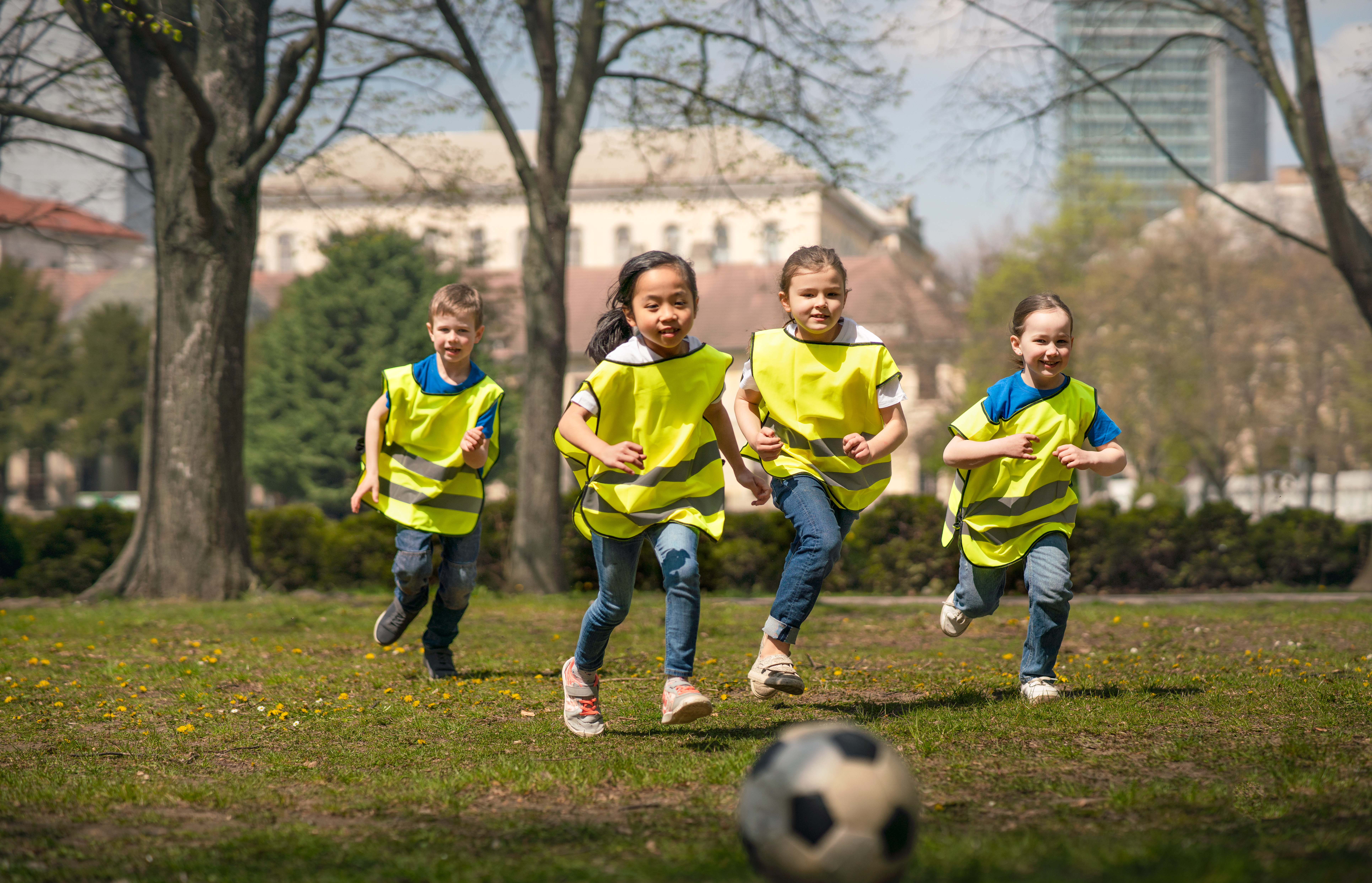
Introduction
There are pivotal stages in childhood that shape a child’s trajectory toward adulthood. From infancy to adolescence, each phase presents unique opportunities for growth and development. Movement is a fundamental component of a child’s developmental milestones. In this article, we’ll look at the critical stages of childhood development, explore the integral role of movement within each stage, and highlight the importance of nurturing movement to unlock children’s full potential. We’ll also touch briefly on the impact of sedentary lifestyles and technology use on the developing brain and body and the risks associated with a lack of movement in childhood.
Infancy: Laying the Foundation for Movement
In infancy, every movement is a triumph – from the first tentative grasp to the exhilarating moment of rolling over. This stage is marked by rapid physical and neurological development, with movement as the primary mode of interaction with the environment. Infants develop crucial motor skills, strengthen muscles, and establish neural connections that form the basis of future movement abilities through activities like tummy time, crawling, and reaching for objects. Early movement experiences lay the foundation for sensory integration, spatial awareness, and motor coordination, setting the stage for future physical competence and overall well-being.

Toddlers: Mastering Mobility and Independence
As children transition into toddlers, the world becomes a playground of endless exploration and discovery. Significant leaps in motor development characterise this stage, as toddlers learn to walk, run, and climb with newfound confidence and determination. Movement becomes a tool for asserting independence as toddlers navigate their environment and assert their autonomy. Through active play and physical exploration, toddlers refine motor skills, develop spatial awareness, and hone problem-solving abilities. Movement experiences during this critical stage shape physical health, cognitive development, and emotional regulation, laying the groundwork for future success.

Childhood: Integrating Movement into Learning and Play
Movement becomes a central component of learning and social interaction in early childhood. This stage is characterised by a natural curiosity and eagerness to explore the world through play and movement. From imaginative play to structured activities like dance and sports, children engage in various movement experiences that foster creativity, collaboration, and problem-solving skills. Movement becomes a means of self-expression as children experiment with different movements and discover their physical capabilities. Research [7] suggests that movement enhances cognitive function, supports emotional regulation, and promotes social skills development, highlighting its integral role in holistic development.

Adolescence: Harnessing Movement for Growth and Resilience
Movement plays a crucial role in physical, cognitive, and emotional development in adolescence. This stage is marked by rapid growth spurts, hormonal changes, and increased academic pressures, making movement essential for managing stress and promoting well-being. Engaging in regular physical activity not only supports physical health but also enhances cognitive function, academic performance, and emotional resilience. Movement provides adolescents opportunities for self-expression, social connection, and personal growth, fostering a sense of identity and belonging. By prioritising movement during adolescence, parents and educators can empower youth to thrive physically, academically, and emotionally – setting the stage for a vibrant and fulfilling future.

Technology: The Troubling ‘Counter-Movement’
Technology use has emerged as a counter-movement to traditional physical activity and movement-based play. Sedentary behaviours, such as excessive screen time and passive media consumption, have become increasingly prevalent among children, posing challenges to physical health and cognitive development. Research suggests that prolonged screen time may contribute to obesity, poor posture, and reduced physical fitness in children. [8] Moreover, excessive technology use has been linked to attention deficits, decreased social interaction, and disrupted sleep patterns, impacting overall well-being. As children spend more time engaged with screens, balancing technology use with opportunities for movement and physical activity becomes paramount for promoting optimal development and maximising potential.
Conclusion
Movement emerges as a thread between physical health, cognitive function, and emotional well-being. Each stage of childhood development, from infancy to adolescence, represents an opportunity for nurturing movement and unlocking children’s full potential. By recognising the critical role of movement in shaping holistic development and addressing the challenges posed by sedentary lifestyles and technology use, we can empower children to thrive physically, cognitively, and emotionally.
Read more: To learn more about the importance of movement for optimal health and well-being, read our blog: https://chiropracticlife.com.au/move-more-live-better
References
1. Duncombe, R. (Ed.). (2019). The physical development needs of young children (1st ed.). Routledge.
2. Durham, K., Wethmar, D., Brandstetter, S., Seelbach-Göbel, B., Apfelbacher, C., Melter, M., Kabesch, M., & Kerzel, S. (2021). Digital Media Exposure and Predictors for Screen Time in 12-Month-Old Children: A Cross-Sectional Analysis of Data From a German Birth Cohort. Frontiers in Psychiatry, 12, 737178–737178. https://doi.org/10.3389/fpsyt.2021.737178
3. Early childhood development : concepts, methodologies, tools, and applications. (2018). IGI Global. https://doi.org/10.4018/978-1-5225-7507-8
4. Flensborg-Madsen, T., & Mortensen, E. L. (2018). Developmental Milestones During the First Three Years as Precursors of Adult Intelligence. Developmental Psychology, 54(8), 1434–1444. https://doi.org/10.1037/dev0000545
5. Schmidt Morgen, C., Andersen, A.-M. N., Due, P., Neelon, S. B., Gamborg, M., & Sørensen, T. I. A. (2014). Timing of motor milestones achievement and development of overweight in childhood: a study within the Danish National Birth Cohort. Pediatric Obesity, 9(4), 239–248. https://doi.org/10.1111/j.2047-6310.2013.00177.x
6. Zhuo, H., Xiao, J., Tseng, W. L., & Liew, Z. (2022). Developmental Milestones of Infancy and Associations with Later Childhood Neurodevelopmental Outcomes in the Adolescent Brain Cognitive Development (ABCD) Study. Children (Basel), 9(10), 1424-. https://doi.org/10.3390/children9101424
7. Michael Yogman, MD; Andrew Garner, MD; Jeffrey Hutchinson, MD; Kathy Hirsh-Pasek, PhD; Roberta Michnick Golinkoff, PhD; COMMITTEE ON PSYCHOSOCIAL ASPECTS OF CHILD AND FAMILY HEALTH; COUNCIL ON COMMUNICATIONS AND MEDIA; Rebecca Baum, MD; Thresia Gambon, MD; Arthur Lavin, MD; Gerri Mattson, MD; Lawrence Wissow, MD; David L. Hill, MD; Nusheen Ameenuddin, MD; Yolanda (Linda) Reid Chassiakos, MD; Corinn Cross, MD; Rhea Boyd, MD; Robert Mendelson, MD; Megan A. Moreno, MD; MSEd; Jenny Radesky, MD; Wendy Sue Swanson, MD; MBE; Jeffrey Hutchinson, MD; Justin Smith, MD, 2018, ‘The Power of Play: A Pediatric Role in Enhancing Development in Young Children’, Pediatrics (2018) 142 (3): e20182058., https://doi.org/10.1542/peds.2018-2058
8. Thomas N. Robinson, MD; Jorge A. Banda, PhD; Lauren Hale, PhD; Amy Shirong Lu, PhD; Frances Fleming-Milici, PhD; Sandra L. Calvert, PhD; Ellen Wartella, PhD, 2017, ‘Screen media exposure and obesity in children and adolescents’, Pediatrics, 140 (Supplement_2): S97–S101.https://doi.org/10.1542/peds.2016-1758K

Recent Comments